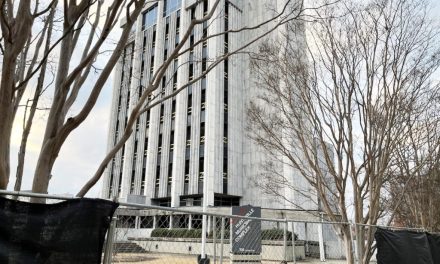
By Shaela Foster,
Special to the AFRO
Therapy in the Black community is a taboo and rarely spoken about within different generations. For some, breaking this generational cycle is key. More and more people are engaging in various forms of healing– that don’t hinge on talk therapy– as a way of normalizing self-care in the Black community.
Walking is an alternative Brandon Shaw McKnight loves. McKnight, 31, is from Baltimore and first got introduced to walking as a form of therapy while living in New York. He was financially struggling and going through a bad breakup so he walked everywhere. He soon realized it assisted him in clearing his mind.

“It’s just a sense of peace that you get, a sense of independence, a sense of freedom…and a sense of awareness,” he said. “When you drive you can be aware, but you miss a lot of things.”
Clearing his mind is the main goal, but it also teaches him how to have habits and remain consistent.
These days, McKnight still does not use a car to get around, so walking or taking public transportation are his main sources of getting around the city of Baltimore.
“This is a pretty city so there are a lot of hidden places too that I would have never known had I just driven everywhere,” he said. “There are a lot of places in this city alone that you probably only can get to if you walk through them.”
McKnight enjoys being around trees, so walking through places like Cromwell Valley Park, Loch Raven Reservoir or Patterson Park, satisfies this enjoyment.
“You never know who you’re going to meet when you’re walking and opportunities that come,” he said. “A lot of times I run into people I haven’t seen in a long time because I decided to walk in the park that day.”
McKnight enjoys walking alone, but sometimes will walk with a friend or group, allowing them to create a deeper connection. According to Harvard Medical School, walking boosts your immune system, eases joint pain and reduces the risk of breast cancer.
“Which I think really just deepened our friendship and gave us things to talk about and more time to spend with each other, not eating food or going out spending money but just walking through parks, expressing ourselves and if there’s anything else we need to know,” he said.

(Courtesy photo)
While McKnight touts the benefits of walking, yoga the healing method of choice for 40-year-old yoga therapist Nazaahah Amin.
Her journey with yoga has transpired over three stages as she’s attempted to maintain her emotional and mental health. She observed how it was alleviating pain and stress. The National Institute of Health credits yoga as an alternative treatment method for depression, anxiety, chronic pain and improving sleeping patterns.
“The more I practiced yoga, the more I accepted what the body was going through,” she said. “The more I was able to kind of lean into ‘oh I don’t have to feel this sad about what’s happening to me, I can find my joy.’”
Amin knew gatekeeping wasn’t an option, she wanted her community to know of the possible healing properties yoga could have on their life. With this, she created Ama Wellness, a Black-owned yoga therapy studio at 636 N. Gilmore St. that specializes in introducing Black women and girls to the world of yoga therapy.
At Ama Wellness, she offers group, individual and organizational workshops. In her group workshop titled “Sistas Yoga Series,” which she said is “intentionally intimate” she takes students through various yoga poses, mediations and breathing exercises over the course of six weeks.
At the end of each session, they engage in a “sista circle” where they’re able to speak on different topics that affect the Black community, specifically Black women.
“Within that session it is also that emotional release,” she said. “I know things are going to come out for them and I’m prepared and trained to deal with it. We may have a box of Kleenex in the middle of the floor because somebody’s going to cry, some tears are going to fall within this session.”
She believes yoga is an approachable way for Black people to begin their healing journey, but shared that before you can start practicing you must silence your mind.
“I knew that before you can even move your body, you have to first love your body. You have to be comfortable in your body,” she said. “You have to quiet your outside life enough to say ‘for these 60 minutes, these 90 minutes, these 10 minutes, I’m going to sit and I’m going to allow my emotions to come up.’ You can’t do a balanced pose if you have all these things attacking you everyday.”
Amin sees yoga therapy as very accessible. She stated you need to be in a specific tax bracket or live in a certain zip code to practice yoga.
“It is one of the greatest tools that we have because it literally utilizes what we already own and you don’t need money to move your body,” she said. “We are 1,000 percent worthy of this healing, our community needs it more than anything. So if you have those opportunities, if you can connect with a class that speaks to you, do it.”
Aside from physical movement, the written word can also serve as a healing tool.
Journaling is a way to release emotions through writing and it can take many forms. Journaling can be a daily list of things one is grateful for or a short reflection on emotions that came up during the day.
If it’s used for reflecting on emotions, writing down the event from start to finish allows someone to separate themselves from their feelings, focusing on the details to then fully process them. Here they note how they feel and how to move forward with these feelings in mind.
Journaling is customizable giving participants the leeway to create anything. This can occur with tape, doodling or different colored pens or pencils.
If journaling alone is frightening, inviting friends or family over to have journaling sessions could potentially ease the anxious feelings surrounding confronting past experiences.
Similar to yoga therapy, journaling forces people to sit with their emotions and not run away from them. Amin states there are lots of stages Black people go through before they engage with yoga poses. Journaling could be a stage for someone.
“If it’s showing up in your spirit— it’s ready to be dealt with,” Amin said. “Maybe you don’t go all the way in, but do the beginning stage.”
The post Three forms of healing you can try today appeared first on AFRO American Newspapers .











